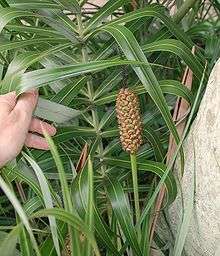Allagoptera
| Allagoptera | |
|---|---|
 | |
| A. arenaria | |
| Scientific classification | |
| Kingdom: | Plantae |
| (unranked): | Angiosperms |
| (unranked): | Monocots |
| (unranked): | Commelinids |
| Order: | Arecales |
| Family: | Arecaceae |
| Subfamily: | Arecoideae |
| Tribe: | Cocoeae |
| Genus: | Allagoptera Nees[1] |
| Species | |
| |
Allagoptera is a monoecious genus of flowering plant in the palm family found in South America consisting of 5 accepted species. Compared to other genera within the Cocoeae Allagoptera is described as particularly specialized.[2] The genus name is a Greek combination of "change" and "feather", describing the full leaf; it was formerly named Diplothemium.
Description
Allagoptera produces very short or acaulescent trunks and in cases where the trunk grows erect it often makes a downward turn leaving the crown below the trunk-base. The trunks in Allagoptera are among the few in the palm family which tend to bifurcate, producing multiple heads per unit. The pinnate leaves are gently arching to 2 m and are carried on long, slender petioles which are adaxially channeled. The single-fold leaflets are regularly or irregularly arranged on the rachis each protruding into a different plane, creating a plumose leaf. The unusual spicate inflorescence emerges from within the leaf-crown carrying the pistilate flowers basally with the staminate flowers growing distally. The single-seeded fruit is yellow to brown, growing in crowded clusters.[3]
Distribution and habitat
Palms in this genus are found in Brazil, Paraguay, Bolivia, and Argentina growing in a variety of habitats. Some thrive in sandy beaches and dunes, while others are found in woodlands; Allagoptera species are also common along sandstone hills and in the Cerrado vegetation.
References
- ↑ C.D.G. Nees in Wied-Neuwied, Reis nach Brasilien 2:335. 1821. Type:A. pumila (=A. arenaria (Gomes)) Diplothemium Martius, Palmarum Familia 20. 1824.
- ↑ Uhl, Natalie W. and Dransfield, John (1987) Genera Palmarum - A classification of palms based on the work of Harold E. Moore. Lawrence, Kansas: Allen Press. ISBN 0-935868-30-5 / ISBN 978-0-935868-30-2
- ↑ Riffle, Robert L. and Craft, Paul (2003) An Encyclopedia of Cultivated Palms. Portland: Timber Press. ISBN 0-88192-558-6 / ISBN 978-0-88192-558-6